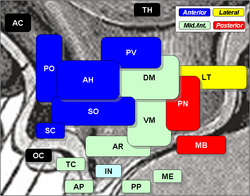- Arcuate nucleus
-
This article is about the hypothalamic structure. For the structure in the medulla oblongata, see Arcuate nucleus (medulla).
Brain: Arcuate nucleus Arcuate nucleus is 'AR', at bottom center, in green. Latin nucleus arcuatus hypothalami Part of Hypothalamus NeuroNames hier-378 MeSH Arcuate+nucleus The arcuate nucleus (or infundibular nucleus[1]) is an aggregation of neurons in the mediobasal hypothalamus, adjacent to the third ventricle and the median eminence. The arcuate nucleus includes several important populations of neurons, including: neuroendocrine neurons, centrally-projecting neurons, and others.
Contents
Neuroendocrine neurons
- Neuroendocrine neurons with nerve endings in the median eminence release dopamine into the hypophysial portal blood. These are sometimes called the "tuberoinfundibular dopamine" (TIDA) neurons. In lactating females, TIDA neurons are inhibited by the stimulus of suckling. Dopamine released from their nerve endings at the median eminence is transported to the anterior pituitary gland, where it regulates the secretion of prolactin; dopamine inhibits prolactin secretion, so, when the TIDA neurons are inhibited, there is increased secretion of prolactin, which stimulates lactogenesis (milk production). Prolactin acts in a short-loop negative feedback manner to decrease its levels by stimulating the release of dopamine. Dopaminergic neurons of the arcuate also inhibit the release of gonadotropin-releasing hormone, explaining in part why lactating (or otherwise hyperprolactinemic) women experience oligomenorrhea or amenorrhea (infrequency or absence of menses).
- Neuroendocrine neurons, mainly in the ventrolateral part of the nucleus, make growth hormone-releasing hormone (GHRH). Like the TIDA neurons, these neurons have nerve endings in the median eminence. GHRH released into the hypophysial portal blood is transported to the anterior pituitary gland, where it regulates the secretion of growth hormone; GHRH stimulates growth hormone secretion. These neurons are inhibited by somatostatin. The reciprocal relationship between the electrical activity of GHRH neurons and somatostatin neurons leads to pulsatile secretion of growth hormone, a pattern of secretion that is important for its biological effectiveness.
Centrally-projecting neurons
- Centrally-projecting neurons that contain neuropeptide Y (NPY), agouti-related protein (AGRP), and the inhibitory neurotransmitter GABA. These neurons, in the most ventromedial part of the nucleus, project strongly to the lateral hypothalamus and to the paraventricular nucleus of the hypothalamus, and are important in the regulation of appetite. When activated, these neurons can produce ravenous eating. These neurons are inhibited by leptin, insulin, and peptide YY and activated by ghrelin.
- Centrally-projecting neurons that contain peptide products of pro-opiomelanocortin (POMC), and cocaine- and amphetamine-regulated transcript (CART). These neurons have widespread projections to many brain areas, including to all nuclei in the hypothalamus. These cells are important in the regulation of appetite, and, when activated, they inhibit feeding. These neurons are activated by circulating concentrations of leptin and insulin, and they are directly innervated and inhibited by the NPY neurons.[2] POMC neurons that project to the medial preoptic nucleus are also involved in the regulation of sexual behavior in both males and females. The expression of POMC is regulated by gonadal steroids. The release of a POMC product, beta-endorphin is regulated by NPY.
- Centrally-projecting neurons that make somatostatin; the neurosecretory somatostatin neurons that regulate growth hormone secretion are a different population, located in the periventricular nucleus.
Other
- A small population of neurons that synthesise ghrelin. The role of this population is not known; many neurons in the arcuate nucleus express receptors for ghrelin, but these are thought to respond mainly to blood-borne ghrelin.
The arcuate nucleus also contains a population of specialized ependymal cells, called tanycytes.
Footnotes
- ^ onderzoekinformatie.nl - Project: Does activation of neurons in the infundibular nucleus in menopause prevent the occurrence of Alzheimer changes?
- ^ Arora and Anubhuti. Role of neuropeptides in appetite regulation and obesity--a review. Neuropeptides (2006) vol. 40 (6) pp. 375-401
References
- Kawano H, Daikoku S (1988). "Somatostatin-containing neuron systems in the rat hypothalamus: retrograde tracing and immunohistochemical studies". J. Comp. Neurol. 271 (2): 293–9. doi:10.1002/cne.902710209. PMID 2897982.
Categories:- Nervous system
- Neuroendocrinology
- Neuroscience stubs
Wikimedia Foundation. 2010.

